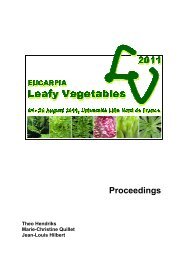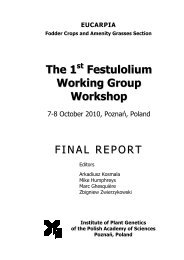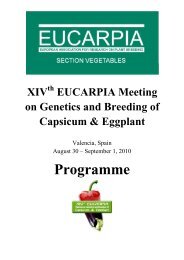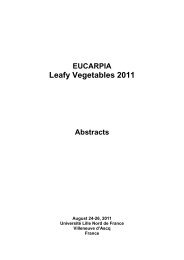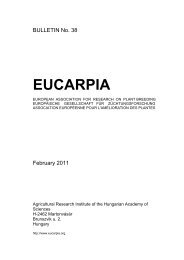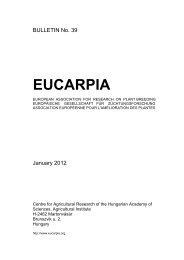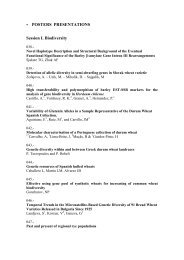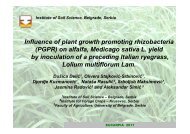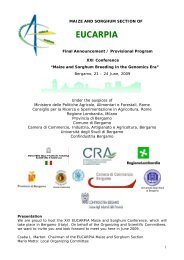Plant breeding for organic and sustainable, low-input agriculture
Plant breeding for organic and sustainable, low-input agriculture
Plant breeding for organic and sustainable, low-input agriculture
Create successful ePaper yourself
Turn your PDF publications into a flip-book with our unique Google optimized e-Paper software.
Relation between growth characteristics <strong>and</strong> yield of barley in different<br />
environments<br />
Kristian Kristensen 1 , Lars Ericson 2<br />
1 University of Aarhus, Tjele, Denmark<br />
2 Swedish University of Agricultural Sciences, Umeå, Sweden<br />
The increasing interest in <strong>organic</strong> farming has increased the interest in examining the importance<br />
of the different growing characteristics, such as attack of diseases, grain weight, lodging <strong>and</strong><br />
heading date. One of the important questions raised was whether the relationship between the<br />
growing characteristics <strong>and</strong> yield would be the same <strong>for</strong> conventionally <strong>and</strong> <strong>organic</strong>ally grown<br />
crop or would some growing characteristics be more important <strong>for</strong> <strong>organic</strong>ally than <strong>for</strong><br />
conventionally grown crops. This work will focus on that question.<br />
The analyses are per<strong>for</strong>med using two datasets with comparable trials in both conventional <strong>and</strong><br />
<strong>organic</strong> grown systems <strong>for</strong> barley (Hordeum vulgare). The two datasets were from Sweden <strong>and</strong><br />
Denmark. From Sweden 22 conventional <strong>and</strong> 22 <strong>organic</strong> grown trials were available. The trials<br />
were laid out at 4 locations in Northern Sweden during the years from 1994-2003. The number<br />
of varieties per trial varied between 7 <strong>and</strong> 15 <strong>and</strong> 50 varieties were represented. Most of the trials<br />
were laid out as split-plot designs with 2 nitrogen levels in the conventional grown trial <strong>and</strong> 2<br />
seed rates in the <strong>organic</strong> grown trials. From Denmark 4 conventional <strong>and</strong> 4 <strong>organic</strong> grown trials<br />
were available. The trials were laid out as α-designs at 2 locations in 2 years (2003 <strong>and</strong> 2004).<br />
The number of varieties per trial varied between 108 <strong>and</strong> 113 <strong>and</strong> 146 varieties were represented.<br />
The data from each country were analysed in a linear mixed model. The effects of location, year,<br />
variety, their interaction <strong>and</strong> interaction with system were included as r<strong>and</strong>om effect. The effect<br />
of growing system <strong>and</strong> growing characteristics were included as fixed effects to see how much of<br />
the variation caused by varieties <strong>and</strong> interaction with varieties that could be explained by the<br />
growing characteristic <strong>and</strong> to se if the effect of the growing characteristics depended on the<br />
growing system.<br />
The analyses showed that the growing characteristics could explain a considerable part of the<br />
variance components <strong>for</strong> variety or interaction with variety. The effect of some growing<br />
characteristics depended significantly on the growing system, but the results varied to some<br />
extent between the two countries. In Sweden the effect of volume weight were more important in<br />
the conventional grown trials than in the <strong>organic</strong> grown trials whereas in Denmark grain weight<br />
was more important in the <strong>organic</strong> grown trials than in the conventional grown trials. In<br />
Denmark powdery mildew decreased the yield significantly more in conventional grown trials<br />
than in <strong>organic</strong> grown trials. In most cases the other diseases decreased the yield more in the<br />
<strong>organic</strong> grown trials than in the conventional grown trials. In some models the yield in <strong>organic</strong><br />
grown trials increased as the level of scald attach increased. The results indicated that the effect<br />
of a given disease level decreased the yield more in the conventional grown trials than in the<br />
<strong>organic</strong> grown trials – or in some cases increased the yield in the <strong>organic</strong> grown trial while the<br />
yield in conventionally grown trials were increased less or decreased.<br />
16




